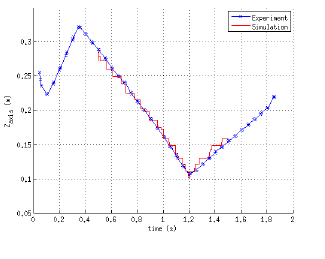Section: New Results
Evolutive equilibrium and transport coupling and optimization of scenarii
Participants : Jacques Blum, Cédric Boulbe, Blaise Faugeras.
New developments in the direct evolutive version of CEDRES++
External circuits and saddle currents in the blankets
In the previous version of the free boundary equilibrium code CEDRES++, each PF-coil (Poloidal Field Coil) was considered separately. In the evolutive version, a voltage was applied to each coil. In the machine, PF-coils can be connected in series or in parallel with one or several power supplies. In order to consider more realistic configurations of the PF system, the model used in CEDRES++ has been generalized to circuits involving several coils and supplies connected in series or in parallel. This model has been implemented in CEDRES++ and has been tested on simple configurations with circuits composed of one supply and several coils connected in series. More complicated configurations like circuits with several supplies and coils in series and in parallel in the same circuit have to be tested. This will be done on a WEST test case. A model for saddle currents in the blankets has also been implemented. This model is actually under validation on DEMO geometry.
Coupling CEDRES++ with a feedback controller (task ITM-WP13-ITM-IMP12-ACT1-T3)
Cedres++ has been successfully coupled with a controller generated from the true TCV hybrid Simulink controller in an ITM (Integrated Tokamak Modeling) workflow. The "yoyo" discharge (shot 40475) has been reproduced. In Figure 1, the vertical position of the magnetic axis simulated matches the experimental one.
|
Cedres++ - transport coupling
Last year, different algorithms coupling free boundary equilibrium solvers and transport solvers (CEDRES++-diff, CEDRES++-CRONOS, CEDRES++-ETS, FREEBIE-CRONOS) have been developed. The ETS-C coupling between CEDRES++ and the transport solver under the ITM environment has been finalized this year. A simulation of a VDE test case has been performed (task WP13-ITM-IMP12-ACT1-T2). A benchmark between the different strategies has been performed in order to validate the numerical methods required to ensure stability of the coupling system and to compare the physical simulations of each model. A benchmark between CEDRES++-diff solving the resistive diffusion equation coupled to CEDRES and the CEDRES-CRONOS coupling has been performed on an ITER test case. Some divergences between the two codes appear and are not fully understood despite long investigations. This difficulty has led us to delay the introduction of non inductive terms in the resistive diffusion equation implemented in CEDRES++-diff. These developments will be realized when the different coupling strategies will be fully validated.
Reasearch of optimal trajectories for the preparation of Tokamak discharges
A new approach has been developed for the optimization of dynamic plasma scenarios in tokamaks. This task has been formulated as an optimal control problem, using numerical solution methods for optimization problems with PDE constraints. Due to free boundary setting, a new linearization of the non-linear equations has been introduced, which is consistent with the numerical discretization. It is this consistency that guarantees that the method converges to the optimum.



